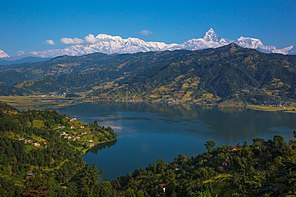
Back ফেওয়া হ্রদ Bengali/Bangla Phewa Tāl CEB Phewa-See German फेवा ताल DTY Πέγουα Greek Phewa Spanish Phewa (Drano) Fiji Lac Phewa French Lago Phewa Italian ペワ湖 Japanese
| Phewa Lake | |
|---|---|
| Phewa Tal, Baidam Tal | |
| फेवा ताल (Nepali) | |
 Reflection of the Annapurna Range on Phewa Lake | |
| Location | Kaski |
| Coordinates | 28°12′51″N 83°56′50″E / 28.21417°N 83.94722°E |
| Lake type | Freshwater |
| Primary inflows | Harpan, Adheri khola & Phirke Khola |
| Catchment area | 122.53 km2 (47.31 sq mi) |
| Basin countries | Nepal |
| Max. length | 4 km (2.5 mi) |
| Max. width | 2 km (1.2 mi) |
| Surface area | 5.7260 km2 (2.2 sq mi) |
| Average depth | 8.6 m (28 ft) |
| Max. depth | 24 m (79 ft) |
| Water volume | 0.046 km3 (0.011 cu mi) |
| Surface elevation | 742 m (2,434 ft) |
| Frozen | Does not freeze |
| Islands | Tal Barahi (तालबाराही), Temple |
| Settlements | Pokhara, Sarangkot, Kaskikot, Dhikurpokhari |
 | |
Phewa Lake, Phewa Tal or Fewa Lake (Nepali: फेवा ताल, [ˈpʰewa tal]) is a freshwater lake in Nepal formerly called Baidam Tal located in the south of the Pokhara Valley that includes Pokhara city and parts of Sarangkot and Kaskikot. [1] It is the second largest lake in Nepal and the largest in Gandaki Province after the Rara lake in comparison to Nepal's water bodies.[2] It is the most popular and most visited lake in Nepal. Phewa lake is located at an altitude of 742 m (2,434 ft) and covers an area of about 5.7 km2 (2.2 sq mi).[3] It has an average depth of about 8.6 m (28 ft) and a maximum depth of 24 m (79 ft).[4] The maximum water capacity of the lake is approximately 43,000,000 cubic metres (35,000 acre⋅ft).[5] The Annapurna range on the north is only about 28 km (linear distance) away[6] from the lake. The lake is also famous for the reflection of mount Machhapuchhre and other mountain peaks of the Annapurna and Dhaulagiri ranges on its surface.[7] The Tal Barahi Temple is situated on an island in the lake.[8] It is located 4 km from the city's centre Chipledhunga.
- ^ Shrestha, P; Janauer, G. A. (2001). "Management of Aquatic Macrophyte Resource: A Case of Phewa Lake, Nepal" (PDF). Environment and Agriculture: Biodiversity, Agriculture and Pollution in South Asia. Ecological Society (ECOS): 99–107. Archived from the original (PDF) on 2014-02-01. Retrieved 2012-04-25.
- ^ Aryal, Vijay (28 October – 2 November 2007). "Phewa Lake Watershed Area: A Study on the Challenges to Human Encroachment" (PDF). Proceedings of Taal 2007: The 12th World Lake Conference, Jaipur, India. International Lake Environment Committee: 2292–2299.[permanent dead link]
- ^ Rai, Ash Kumar (2000). "Evaluation of natural food for planktivorous fish in Lakes Phewa, Begnas, and Rupa in Pokhara Valley, Nepal". Limnology. 1 (2): 81–89. doi:10.1007/s102010070014. S2CID 23782376.
- ^ Shrestha, Purushottam (2003). "Conservation and management of Phewa Lake ecosystem, Nepal" (PDF). Aquatic Ecosystem Health and Management Society. pp. 1–4. Archived from the original (PDF) on 2013-10-08. Retrieved 2012-04-25.
- ^ Pokharel, Shailendra (2003). "Lessons from Nepal on Developing a Strategic Plan for the Integrated Lake Basin Management: Conservation of Phewa Lake of Pokhara, Nepal" (PDF). International Lake Environment Committee: World Lake Database. Archived from the original (PDF) on 2014-02-03. Retrieved 2012-04-25.
- ^ Gulia, K. S. (2007). "Himalayan Treks in Nepal". Discovering Himalaya: Tourism of Himalayan Region. Delhi, India: Isha Books. p. 63. ISBN 978-81-8205-410-3.
- ^ Giri, Bikash; Chalise, Mukesh Kumar (2008). "Seasonal Diversity and Population Status of Waterbirds in Phewa Lake, Pokhara, Nepal". Journal of Wetlands Ecology. 1 (1/2): 3–7. doi:10.3126/jowe.v1i1.1568.
- ^ Shrestha, Nanda R. (1997). "Pot Goes Pop on Kathmandu's Freak Street". In the Name of Development: A Reflection on Nepal. Lanham, Maryland: University Press of America. p. 163. ISBN 0-7618-0758-6.
